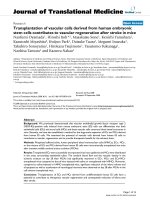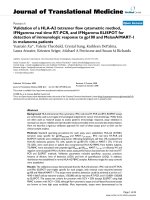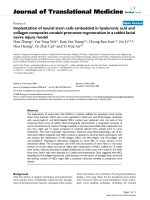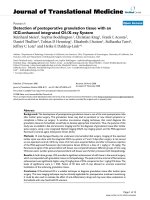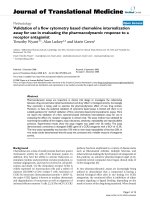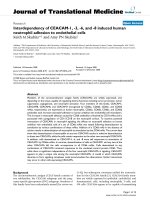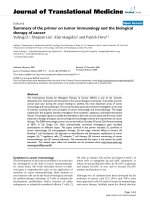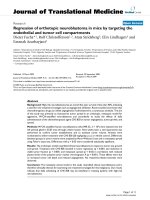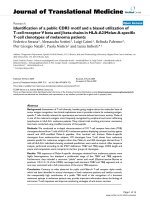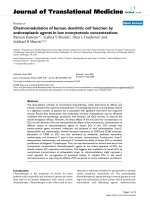báo cáo hóa học: " Assessment of level-walking aperiodicity" potx
Bạn đang xem bản rút gọn của tài liệu. Xem và tải ngay bản đầy đủ của tài liệu tại đây (370.25 KB, 9 trang )
BioMed Central
Page 1 of 9
(page number not for citation purposes)
Journal of NeuroEngineering and
Rehabilitation
Open Access
Methodology
Assessment of level-walking aperiodicity
Fabrizio Pecoraro, Claudia Mazzà*, Mounir Zok and Aurelio Cappozzo
Address: Department of Human Movement and Sport Sciences, Istituto Universitario di Scienze Motorie, Rome, Italy
Email: Fabrizio Pecoraro - ; Claudia Mazzà* - ; Mounir Zok - ;
Aurelio Cappozzo -
* Corresponding author
Abstract
Background: In gait analysis, walking is assumed to be periodic for the sake of simplicity, despite
the fact that, strictly speaking, it can only approximate periodicity and, as such, may be referred to
as pseudo-periodic. This study aims at: 1) quantifying gait pseudo-periodicity using information
concerning a single stride; 2) investigating the effects of walking pathway length on gait periodicity;
3) investigating separately the periodicity of the upper and lower body parts movement; 4) verifying
the validity of foot-floor contact events as markers of the gait cycle period.
Methods: Ten young healthy subjects (6 males, 23 ± 5 years) were asked to perform various gait
trials, first along a 20-m pathway that allowed reaching a steady-state condition, and then along an
8-m pathway. A stereophotogrammetric system was used to reconstruct the 3D position of
reflective markers distributed over the subjects' body. Foot contact was detected using an
instrumented mat. Three marker clusters were used to represent the movement of the whole
body, the upper body (without upper limbs), and the lower body, respectively. Linear and rotational
kinetic, and gravitational and elastic potential "energy-like" quantities were used to calculate an
index J(t) that described the instantaneous "mechanical state" of the analysed body portion. The
variations of J(t) in time allowed for the determination of the walking pseudo-period and for the
assessment of gait aperiodicity.
Results: The suitability of the proposed approach was demonstrated, and it was shown that, for
young, healthy adults, a threshold of physiological pseudo-periodicity of walking at natural speed
could be set. Higher pseudo-periodicity values were found for the shorter pathway only for the
upper body. Irrespective of pathway length, the upper body had a larger divergency from
periodicity than the lower body. The error that can be made in estimating the gait cycle duration
for the upper body from the heel contacts was shown to be significant.
Conclusion: The proposed method can be easily implemented in gait laboratories to verify the
consistency of a recorded stride with the hypothesis of periodicity.
Background
When performing gait analysis, subjects are normally
asked to walk at a constant speed of progression (at
steady-state). The resulting estimated kinematic and
kinetic quantities are assumed to be periodic, and, as
such, are described with reference to a single walking cycle
[1,2]. This cycle is commonly defined by the interval of
time (T) that starts at the initial contact of one foot and
Published: 07 December 2006
Journal of NeuroEngineering and Rehabilitation 2006, 3:28 doi:10.1186/1743-0003-3-28
Received: 29 May 2006
Accepted: 07 December 2006
This article is available from: />© 2006 Pecoraro et al; licensee BioMed Central Ltd.
This is an Open Access article distributed under the terms of the Creative Commons Attribution License ( />),
which permits unrestricted use, distribution, and reproduction in any medium, provided the original work is properly cited.
Journal of NeuroEngineering and Rehabilitation 2006, 3:28 />Page 2 of 9
(page number not for citation purposes)
ends at the following contact of the same foot [2,3]. It is
evident that the biological phenomenon that is dealt with
is assumed to be periodic for the sake of simplicity, but,
strictly speaking, it can only approximate periodicity and
it may be referred to as pseudo-periodic [4].
The cyclic nature of gait data patterns emerges from gait
initiation and is ultimately clearly identifiable only during
steady-state pace. Since such pace is reached after negoti-
ating some steps [5], short walking pathways, as found in
many gait laboratories, might be one of the causes that
contribute to the pseudo-periodicity in the recorded data.
This might in turn reflect into an undesired augmented
variability in the data, hiding the valuable information
obtainable from variability analysis [6-8].
When talking about gait periodicity, reference should be
made to the mechanical state of the locomotor system and
to its reiteration after a given interval of time. Relevant
state variables can be derived from the quantities nor-
mally measured in the gait analysis laboratory, such as
joint angles [9] or mechanical energies [5]. Starting from
a reference instant of time, the system mechanical state
variation, determined in any subsequent instant of time,
provides a measure of the aperiodicity of the phenome-
non as observed in that interval of time. When this varia-
tion reaches a minimum value, aperiodicity is at a
minimum and, therefore, the corresponding interval of
time may be considered as the best estimate of the
pseudo-period ( ) and the relevant mechanical state var-
iation as a measure of pseudo-periodicity or aperiodicity.
The normally used foot-floor contacts represent a very
partial description of the locomotor system mechanical
state and, as such, may be not fully adequate for the deter-
mination of the walking pseudo-period.
The above considerations lead to the formulation of the
following questions, which this paper aims at providing
an answer:
1. Given a gait stride, perceived by the walking subject as
performed at steady-state, how far is it from being a cycle
of a periodic phenomenon and is it associated with a
pseudo-periodic or an aperiodic gait?
2. Does a limited walking pathway length cause an
increase in gait pseudo-periodicity?
3. As far as the above listed issues are concerned, is there a
difference between the pseudo-periodic characteristics of
the movements of the lower part and those of the upper
part of the body?
4. How valid is the foot-floor contact method for deter-
mining the duration (pseudo-period) of the walking
cycle?
In principle, the hypothesis of periodicity should be veri-
fied and quantitatively assessed by comparing relevant
quantities recorded during a series of consecutive strides.
However, this is hardly ever possible when using stereo-
photogrammetry and dynamometry, since the measure-
ment volume normally does not host more than three
consecutive steps. A method for the quantification of the
discrepancy between periodicity and pseudo-periodicity
or aperiodicity of walking through the observation of a
single gait stride will be proposed in this paper. The infor-
mation provided by this method is expected to be useful
for two reasons: from a heuristic point of view, it allows
an insight into a possible methodological, external, cause
of the variability of gait strides [10], and, from a practical
standpoint, it allows for a control of the consistency of the
observed gait stride with the hypothesis of steady state.
Materials and methods
Subjects and protocol
Ten young healthy subjects (6 males, 23 ± 5 years, 62 ± 12
kg, 1.68 ± 0.08 m) volunteered for the study and signed an
informed written consent. Subjects participated in two
sets of experiments each characterised by a different walk-
ing pathway length. They were asked to walk along the lin-
ear pathways at three different self-selected speeds of
progression: slow (SS, "walk at a slow speed"), natural
(NS, "walk naturally") and fast (FS, "walk as fast as you
can"). In all cases the subjects were explicitly asked to
reach and maintain a constant speed of progression. Three
trials were performed for each condition.
Instrumentation
A purposely built instrumented mat was used to measure
the beginning (t
b
) and end (t
e
) of a stride determined by
the consecutive contacts of the same foot with the mat,
and relevant stride duration (T) was then computed as T =
t
e
– t
b
. Adhesive 5 mm wide copper stripes were attached
parallel to each other at a 3 mm distance along a 4 m
length linoleum mat. Alternative stripes were connected
to an electric circuit so that, when short circuited, a signal
was generated. Two independent circuits were constructed
for right and left foot. Subjects wore custom designed
socks, the bottom part of which was covered with conduc-
tive material. The accuracy of the mat was assessed by
comparing its data to those simultaneously acquired with
a strain gauge force plate (Bertec Corporation, Ohio, USA,
sample frequency = 120 samples/s) while a subject
stepped on it. The first sample at which the vertical force
was greater than its mean value plus two standard devia-
tions recorded for 1 s while the force plate was unloaded,
was chosen as indicator of the foot contact. The differ-
ˆ
T
Journal of NeuroEngineering and Rehabilitation 2006, 3:28 />Page 3 of 9
(page number not for citation purposes)
ences found between the time events detected with the
mat and with the force plate were computed for ten differ-
ent trials, and were always lower than 0.025 s.
A nine-camera VICON
®
system (Oxford Metrics, Oxford,
UK) was used to reconstruct the 3D positions, relative to
the stereophotogrammetric set of axes, of 19 markers
placed on the body of the subjects. The markers were
placed on the head (three markers attached on an elastic
band), trunk (spinal process of the seventh cervical verte-
bra, acromion processes), pelvis (anterior superior iliac
spines, midpoint between the posterior superior iliac
spines), and lower limbs (greater trochanters, femoral lat-
eral epicondyles, lateral malleoli, calcanei, and second
metatarsal heads). From now on, the cluster composed by
all the above listed markers will be referred to as whole
body (WB) cluster. Two sub-clusters will also be consid-
ered: the lower body (LB) cluster, including the 13 mark-
ers located on pelvis and lower limbs, and the upper body
(UB) cluster, including the 9 markers located on head,
trunk and pelvis. While defining the latter cluster, it was
decided not to include upper limb markers because of the
low sensitivity of the overall gait pattern to the movement
of the upper limbs, which, for this reason, may tend to be
more aperiodic than that of the rest of the body. In addi-
tion, most gait analysis protocols do not include these seg-
ments.
Stereophotogrammetric and mat data were simultane-
ously collected at a sampling frequency of 120 samples/s.
Experiments
As mentioned previously, two sets of experiments were
performed. The first set aimed at placing the subjects in
the best condition for reaching steady-state walking and at
properly assessing periodicity by observing more than a
single stride. The second set aimed at simulating a stand-
ard laboratory situation where only a single stride per
limb fits in the measurement volume and the walking
pathway length is limited.
The first set of experiments was performed exploiting the
entire length of a 20 × 8 m laboratory such that subjects
were able to walk for at least twelve consecutive strides
and the stereophotogrammetry measurement volume
hosted two strides per limb (among the fifth, sixth and
seventh stride). This pathway allowed the subjects to
reach what they perceived to be a steady-state walking
pace [5].
The second set of experiments used the same protocol as
described above, but was carried out along an 8-m path-
way and within a stereophotogrammetric measurement
volume that hosted only three consecutive steps.
Data analysis
Through a rigid transformation, 3-D marker position data
were represented relative to a laboratory set of axes, the X
axis of which was aligned with the analysed subject mean
speed of progression, and the Y axis was vertical. This data
was filtered through a low-pass fourth-order Butterworth
filter with a cut off frequency of 8 Hz [11] and was used to
describe the variations of the mechanical state of the sub-
jects' whole body, and of its upper and lower parts.
Each cluster was considered as an ensemble of particles
with equal mass and was represented, in each sampled
instant of time during movement and relative to the labo-
ratory frame, by the global position vector (
g
p) of its cen-
tre of mass and by the orientation matrix (
g
R) of an
arbitrarily chosen set of local axes. To this purpose, the
singular value decomposition technique was used [12].
The position vectors of the markers in the local frame is
referred to as
l
p. Using this information, energy-like quan-
tities were calculated and used to describe the instantane-
ous "mechanical state" variation of each cluster and, in
turn, of each related body system. Such variations were
calculated relative to the reference instant of time t
b
.
The vertical coordinate h(t) of the marker cluster centre of
mass was considered to represent a gravitational potential
energy-like quantity G(t). Its variation was calculated as:
ΔG(t) = h(t) - h(t
b
). (1)
The first derivative of the centre of mass position vector
was estimated via a three-point central difference differen-
tiation method. The modulus of the instantaneous veloc-
ity thus obtained (v(t)) was used to calculate a linear
kinetic energy-like quantity K(t). Its variation was given
by:
ΔK(t) = v
2
(t) - v
2
(t
b
). (2)
The instantaneous angular velocity (
ω
(t)) of the cluster
was computed from the orientation matrix
g
R [13]. The
modulus of
ω
(t) was used to calculate a rotational kinetic
energy-like quantity R(t). Its variation was given by:
ΔR(t) =
ω
2
(t) -
ω
2
(t
b
). (3)
Besides height and velocities variations, during move-
ment the clusters may undergo a variation in orientation
and a deformation, both of which were described by elas-
tic potential energy-like quantities. The orientation varia-
tion of a cluster between time t
b
and time t may be
thought to correspond to a rotation of the local set of axes
about the corresponding finite helical axis against an elas-
tic torsional constraint. From the orientation matrices of
the cluster at times t
b
and t, the relevant rotation vector
Journal of NeuroEngineering and Rehabilitation 2006, 3:28 />Page 4 of 9
(page number not for citation purposes)
(θ(t)) was calculated [14]. The following torsional elastic
potential energy-like quantity was, thus, determined:
ΔT(t) = ||θ(t)||
2
. (4)
Similarly, the variation of the markers local position vec-
tors between time t
b
and time t allowed for the calculation
of another elastic potential energy-like quantity associated
with marker cluster deformation:
where N is the number of markers of the relevant cluster.
A measure of the system mechanical state variation, in any
observed interval of time, could be obtained through the
sum of the absolute values of the above-defined energy-
like quantities. However, since such quantities have arbi-
trary dimensions, their values are incomparable and
should hence be normalised. The maximum amplitude of
one (arbitrarily chosen) of the energy-like quantities
could be considered as a reference normalisation factor
for the others. In such way, the variation of the mechani-
cal state of the system can be calculated according to the
following weighed sum:
where k
G
, k
K
, k
R
, k
T
, and k
D
are weighing constants. These
constants, for the i-th trial, are arbitrarily calculated con-
sidering (for example) the maximum amplitude of gravi-
tational potential energy-like quantity as the reference
normalisation factor (i.e. setting k
G
= 1):
However, if different trials are to be compared, a fixed ref-
erence value of the constants should be chosen for all of
them. Since no reference values were available to this pur-
pose, previously (unpublished) available kinematic gait
data, recorded at natural speed from a similarly aged
group of 15 healthy subjects adopting the same instru-
mentation and marker set as the ones in the present study,
were used. The values of the constants were computed as
in (7a-7e) for each trial, and their mean values (k
G
= 1.00,
k
K
= 0.04, k
R
= 0.27, k
T
= 0.05, k
D
= 0.70) were used in the
rest of the study.
The variation of the state of the system during a gait cycle,
starting from a foot contact (t
b
) and normalised with
respect to its maximum value, was assessed by means of
the index:
The sought aperiodicity index was computed as:
J
min
= min (J(t)). (9)
The larger the J
min
value, the further the analysed gait is
from a periodic process. The time instant for which J(t) =
J
min
is proposed as an estimate of the end of the period
(
e
), which can be used to determine the pseudo-period
=
e
- t
b
. The value assumed by J(t) at t
e
, i.e. that meas-
ured by the mat at the end of the stride, will be referred to
as J
e
.
To assess the sensitivity of the index J
min
to the values of
the constants, a set of 100 different combinations of val-
ues was generated by randomly varying them in the ranges
defined by their corresponding mean values plus or
minus one standard deviation, computed over the above
described 75 trials (k
G
= 1.00, k
K
= 0.04 ± 0.03, k
R
= 0.27 ±
0.15, k
T
= 0.05 ± 0.03, k
D
= 0.70 ± 0.19).
As previously mentioned, gait aperiodicity depends on
step length, cadence, and width, which can differently
affect cluster kinematics: step length variation can be
expected to mostly affect h(t), and partly v(t) and
l
p(t);
step cadence variation mostly affects v(t); step width vari-
ation mostly affects h(t) and
l
p(t). Thus, it can be hypoth-
esised that within the same stride, the quantities ΔG(t)
and ΔD(t) are the most sensitive to changes in step length
and width, and the index ΔK(t) to changes in step length
and cadence. Moreover, the two terms ΔR(t) and ΔT(t) are
expected to be negligible when walking straight. In such
case, the equations (6), (8) and (9) can be replaced by the
following:
ΔDt
t t
N
l
i
l
ib
i
N
()
() ( )
,=
−
()
=
∑
pp
2
1
5
Δ
ΔΔΔΔΔ
Et
Gt
k
Kt
k
Rt
k
Tt
k
Dt
k
GKR TD
()
() () () () ()
,=++++
()
6
k
Gt
Gt
a
G
i
i
i
==
()
max ( )
max ( )
Δ
Δ
17
k
Kt
Gt
b
K
i
i
i
=
()
max ( )
max ( )
Δ
Δ
7
k
Rt
Gt
c
R
i
i
i
=
()
max ( )
max ( )
Δ
Δ
7
k
Tt
Gt
d
T
i
i
i
=
()
max ( )
max ( )
Δ
Δ
7
k
Dt
Gt
e
D
i
i
i
=
()
max ( )
max ( )
Δ
Δ
7
Jt
Et
Et
()
()
max ( )
.=×
()
Δ
Δ
100 8
ˆ
t
ˆ
T
ˆ
t
Journal of NeuroEngineering and Rehabilitation 2006, 3:28 />Page 5 of 9
(page number not for citation purposes)
min
= min ( (t)). (9a)
The above described hypotheses were verified by means of
ad-hoc constrained tests. One subject (male, 23 years, 1.70
m, 70 kg) was asked to follow the auditory input of a met-
ronome to modulate step cadence (C), and the visual
input of markers on the floor to control step length (L)
and width (W) while walking along the 8-m pathway. L,
C, and W were first kept unconstrained, and then made to
vary, one at a time, from step to step (ΔL = 0.4 m, ΔC = 1
step/s, ΔW = 0.2 m).
Statistical analysis
The coefficient of determination (R
2
) was used, for both
mat-measured period (T) and pseudo-period ( ), to
assess the equivalence of the duration of the first and sec-
ond stride of the same trial. A two-way ANOVA analysis
was used to assess the effects of two between group fac-
tors: speed (three levels: SS, NS, and FS) and pathway
length (two levels: short, SP, and long, LP). When signifi-
cant differences (p < 0.05) were found, a post-hoc analysis
was performed using an unpaired samples two-tailed t-
test with Bonferroni correction (significance level: p =
0.017). Finally, a two-tailed t-test for paired samples (p =
0.05) was used to compare the results obtained for the
three clusters of markers and to assess the differences
between T and .
Results
The first three steps of the analysis consisted in the valida-
tion of the proposed method in terms of: robustness of
the index J
min
to the variation of the constants k; sensitivity
of the energy-like indices to the gait characteristics; suita-
bility of the method to detect periodicity by observing
changes between subsequent strides.
When varying the five constants in the computed ranges,
the index J
min
varied by less than 10% of its initial value
and the corresponding remained unaltered.
Fig. 1 illustrates, for a representative LP trial, an example
of the variations of the WB indices ΔG(t), ΔK(t), ΔR(t),
ΔT(t), ΔD(t), and J(t) from their values at t
b
. The sensitiv-
ity of these indices to stride parameter variations is illus-
trated by the data reported in Table 1: as expected, J
min
was
sensitive to variations in step length, cadence, and width.
When length and cadence varied, the contribution, at
instant
e
, of ΔG and ΔK to the overall J
min
reached 71%
and 61%, respectively.
The results in Table 1 show that, as hypothesised, the two
terms ΔR(t) and ΔT(t) can be neglected when walking
straight. These indices, in fact, contributed to the overall
J
min
by no more than 5%. As a result, from now onward,
the index
min
will be used for the assessment of periodic-
ity.
An example of the (t) time patterns obtained for the WB
cluster between subsequent strides is reported in Fig. 2. In
particular, the data obtained during the constrained tests
of a representative subject when asked to walk at steady-
state (Fig. 2a) and when asked to vary progression speed
freely between the two strides (Fig. 2b) is illustrated. In
the reported figure, during steady-state, the
min
values
were similar in the two subsequent strides (8.7% and
7.8%, respectively, computed within the relevant T) and
Δ
ΔΔΔ
ˆ
()
() () ()
,Et
Gt
k
Kt
k
Dt
k
a
GKD
=++
()
6
ˆ
()
ˆ
()
max
ˆ
()
,Jt
Et
Et
a=×
()
Δ
Δ
100 8
ˆ
J
ˆ
J
ˆ
T
ˆ
T
ˆ
T
ˆ
t
ˆ
J
ˆ
J
ˆ
J
Example of the time patterns of the "energy-like" indices used to describe the mechanical state of the system during one gait trialFigure 1
Example of the time patterns of the "energy-like" indices
used to describe the mechanical state of the system during
one gait trial. The data along the abscissa are normalised with
respect to the duration of the first stride, determined as =
e
- t
b
.
ˆ
T
ˆ
t
Journal of NeuroEngineering and Rehabilitation 2006, 3:28 />Page 6 of 9
(page number not for citation purposes)
were lower than those obtained when the subject was
accelerating during the first stride (32.2% and 10.3%,
respectively).
Due to the longer stride length at the faster speed, it was
not possible to collect reliable data for two consecutive
strides in the FS experiments performed by the subjects
along the LP. For this reason, only the SS and NS trials
were included in this first part of the analysis. These trials
actually resulted to be pseudo-periodic, since:
a) consecutive strides had the same duration, as shown by
the high coefficient of determination between the dura-
tion of the first (T
1
) and of the second (T
2
) stride (R
2
=
0.97 for T
1
and T
2
and R
2
= 0.90 for
1
and
2
), and
b) the two time curves of (t) obtained in T
1
and T
2
(and
resampled to 100 samples) were highly correlated (Pear-
son correlation coefficient r = 0.92 ± 0.13) and very simi-
lar to each other (RMS = 9 ± 8%). The same stands for the
curves computed using
1
and
2
(r = 0.92 ± 0.12 and
RMS = 10 ± 7%).
The values of
min
obtained for this sub-set of experiments
(WB: 9 ± 9%; LB: 7 ± 6%; UB: 16 ± 15%) can be used to
set a threshold between pseudo-periodicity and aperiodic-
ity for the three clusters of markers.
All the 90 LP trials were then compared with the SP trials
for the three speeds of execution of the task. Mean speeds
of progression, calculated as the product between stride
length and stride frequency, did not significantly change
between SP and LP trials (SS: 0.93 ± 0.22 ms
-1
vs 0.84 ±
0.16 ms
-1
, NS: 1.16 ± 0.18 ms
-1
vs 1.20 ± 0.25 ms
-1
, and
FS: 2.21 ± 0.14 ms
-1
vs 1.91 ± 0.52 ms
-1
).
As reported in Table 2, the results of the ANOVA showed
that the two factors, speed and pathway length, when con-
sidered separately, affected
min
of the UB cluster only: rel-
evant
min
values increased with increasing speed and
shortening of the pathway length (Table 3).
The results of the comparison among the three body clus-
ters are highlighted in Table 3, where the mean (standard
ˆ
T
ˆ
T
ˆ
J
ˆ
T
ˆ
T
ˆ
J
ˆ
J
ˆ
J
The time patterns of (t) are reported for two different tri-
als, one at steady-state (a) and one during which the subject
was deliberately accelerating (b)
Figure 2
The time patterns of (t) are reported for two different tri-
als, one at steady-state (a) and one during which the subject
was deliberately accelerating (b). The vertical dashed lines
indicate the t
e
values recorded from the mat.
ˆ
J
ˆ
J
Table 1: Results of the trials performed by one subject in controlled experimental conditions (the gait factors, namely step length,
cadence, and width, varied from step to step: ΔL = 0.4 m, ΔC = 1step/s, ΔW = 0.2 m, respectively).
Gait Factor J
min
(%) ΔG (%J
min
) ΔK (%J
min
) ΔR (%J
min
) ΔT (%J
min
) ΔD (%J
min
)
None 10 81 10 1 5 3
Length 29 71 5 3 3 19
Cadence211361 1 5 20
Width374636 1 4 13
The percentage contributions of the variation of the gravitational potential (ΔG), linear (ΔK) and rotational (ΔR) kinetic, torsional (ΔT) and
deformation (ΔD) elastic potential energy-like quantities to the total value of Jmin, as computed at , are shown.
ˆ
t
Journal of NeuroEngineering and Rehabilitation 2006, 3:28 />Page 7 of 9
(page number not for citation purposes)
deviation) values of
min
computed in all the experimen-
tal conditions are shown. Whereas no significant differ-
ences were found between the WB and LB, the UB almost
always showed the highest
min
values. The only excep-
tion was relative to walking at NS along LP in which case
min
was not significantly different between WB and UB.
Table 4 shows the results of the comparison between the
stride durations, once estimated ( ) using the marker
clusters and once measured with the mat (T) using the
heel strike. The differences between the two quantities
were, on average, less than or equal to 3% of T for WB and
LB and less than or equal to 7% of T for UB. Significant
differences were observed for all clusters at both SS and
NS, except for WB and LB when walking along LP.
Table 5 shows the results of the ANOVA performed on the
e
values: for all clusters, only the speed factor caused a
significant change in
e
, with the highest values found at
FS along SP (Table 6); for the UB cluster,
e
was not sig-
nificantly different at FS and SS.
The use of t
e
instead of
e
led to an increase in the estimate
of gait pseudo-periodicity: the values of (t) at t
e
(
e
,
Table 6) were significantly higher than those at
e
(
min
,
Table 3) for all clusters in all experimental conditions.
Discussion
The objectives of this study were: 1) to gather information
concerning the periodicity of walking cycles and to set a
threshold between pseudo-periodic and aperiodic walk-
ing; 2) to describe the effects of a limited walking pathway
on gait pseudo-periodicity; 3) to assess differences in the
movements of the lower and of the upper part of the
body; 4) to assess the validity of the foot-floor contact
method for determining the duration (pseudo-period) of
the walking cycle.
To achieve the above listed objectives, a mechanical
energy-like index computed from the kinematic data
recorded during one stride only has been devised. This
method was validated performing ad-hoc experiments
which allowed for the comparison of two consecutive
strides recorded in a pathway which certainly allowed the
subjects to reach the steady-state condition. The results
indicated that the proposed index is suitable for the meas-
ure of gait aperiodicity using one stride only.
ˆ
J
ˆ
J
ˆ
J
ˆ
T
ˆ
J
ˆ
J
ˆ
J
ˆ
t
ˆ
J
ˆ
J
ˆ
t
ˆ
J
Table 3: Mean values (standard deviation) obtained for the two sets of experiments (long pathway, LP, and short pathway, SP) in the
different trial types: slow (SS), natural (NS) and fast (FS) walking speeds.
Trial type
min
- WB (%)
min
- LB (%)
min
- UB (%)
LP SP LP SP LP SP
SS 9 (7) 11 (2) 7 (5) 8 (2) 14 (10)*^ 20 (5)*^
NS 9 (6) 12 (2) 7 (5) 9 (1) 10 (8)^ 20 (5)
§
*^
FS 10 (8) 15 (4) 8 (6) 10 (3) 15 (11)°*^ 27 (7)°
§
*^
The values of the index are reported for the whole body (WB), lower body (LB) and upper body (UB) marker clusters. (°significant differences
between FS and NS; § significant differences between LP and SP; *significant differences between UB and WB; ^significant differences between UB
and LB).
ˆ
J
ˆ
J
ˆ
J
ˆ
J
Table 2: Results of the ANOVA performed on the
min
values obtained for the three clusters of markers.
Factor
min
- WB
min
- LB
min
- UB
FpFp F p
Speed 3.262 0.062 2.526 0.108 7.795 0.004
Pathway Length 2.457 0.151 1.432 0.262 10.862 0.009
Speed × Pathway Length 2.914 0.080 1.192 0.327 2.684 0.095
ˆ
J
ˆ
J
ˆ
J
ˆ
J
Journal of NeuroEngineering and Rehabilitation 2006, 3:28 />Page 8 of 9
(page number not for citation purposes)
The first two objectives were reached by assessing gait
pseudo-periodicity. It was shown that, if considering the
whole body cluster, a value of 18% (mean + one standard
deviation) of the global variation of the mechanical
energy-like index can be considered as a threshold of
physiological pseudo-periodicity of young, healthy adult
gait. Values below this threshold, in fact, were found
when subjects were asked to walk along the 20-m pathway
at NS and SS. Gait periodicity seemed reduced when sub-
jects were asked to walk along the 8-m pathway and this
was most evident at their maximal speed. These differ-
ences, however, were significant only for the upper part of
the body.
The third objective of this study required the assessment
of the periodicity of the different parts of the human
body. In almost all the experimental conditions, the
upper part of the body showed higher aperiodicity than
the lower part. This behaviour can be explained by the
lower number of functional constraints that trunk and
head movements have to comply with during gait. Lower
limbs, in fact, are responsible for forward progression and
must hence act in a quite regular and constrained fashion,
whereas head and trunk can, theoretically, freely behave
while being "carried" by the lower part of the body [15].
Finally, the fourth objective of the paper was tackled and
the validity of considering the foot-floor contact events as
markers of the period of gait cycles was assessed. The error
(mean + one standard deviation) that can be made in esti-
mating the gait cycle duration for the whole body from
the heel contacts, is, on average, less than 3% of the period
in long pathway condition at all gait speeds. This error can
increase up to 5% while walking at fast speed along the
short pathway, and can lead to an increase of the pseudo-
periodicity value from 19% to 27%. The different behav-
iour of lower and upper body described in the above par-
agraph was confirmed by the differences found between
the periods estimated for the two clusters along the 20-m
pathway: whereas the period estimated for the lower body
was the same as that measured from the foot-floor con-
tacts, noticeable differences were recorded for the upper
part of the body. This proves that special attention should
be dedicated when the foot-floor contact method is used
for detecting the period of the whole and lower body
along short pathways, and it should never be considered
valid for the upper body.
Conclusion
This study showed that young, healthy adult human gait
is pseudo-periodic, and this is more marked for the upper
Table 5: Results of the ANOVA performed on the
e
values obtained for the three clusters of markers.
Factor
e
- WB
e
- LB
e
- UB
FpFpFp
Speed 14.624 0.000 21.453 0.000 11.086 0.001
Pathway Length 1.947 0.196 1.002 0.343 3.462 0.096
Speed × Pathway Length 0.801 0.464 0.489 0.621 0.394 0.680
ˆ
J
ˆ
J
ˆ
J
ˆ
J
Table 4: Mean values (standard deviation) of the differences between the stride duration values measured with the mat (T) and those
estimated with the index
min
( ), expressed as a percentage of T.
Trial type WB LB UB
LP SP LP SP LP SP
SS 1 (1) 2 (1) 1 (1) 1 (1) 3 (1) 3 (1)
NS 2 (1) 2 (1) 1 (1) 2 (1) 4 (1) 3 (1)
FS 2 (1) 3 (2) 2 (1) 3 (2) 7 (9) 4 (5)
Results are reported for the two sets of experiments (long pathway, LP, and short pathway, SP). The values in bold indicate the experimental
conditions in which the differences between T and were significant.
ˆ
J
ˆ
T
ˆ
T
ˆ
T
Publish with Bio Med Central and every
scientist can read your work free of charge
"BioMed Central will be the most significant development for
disseminating the results of biomedical research in our lifetime."
Sir Paul Nurse, Cancer Research UK
Your research papers will be:
available free of charge to the entire biomedical community
peer reviewed and published immediately upon acceptance
cited in PubMed and archived on PubMed Central
yours — you keep the copyright
Submit your manuscript here:
/>BioMedcentral
Journal of NeuroEngineering and Rehabilitation 2006, 3:28 />Page 9 of 9
(page number not for citation purposes)
part of the body. A control of aperiodicity should always
be performed if trials are conducted in common gait lab-
oratories. If any instrument is available for the detection
of the beginning of a stride, for example a force plate, then
the proposed index could be used to accurately estimate
stride duration.
Acknowledgements
This study was funded by the authors' University. The collaboration of Pie-
tro Picerno and Domenico Cherubini in the experimental sessions is grate-
fully acknowledged.
References
1. Cappozzo A, Leo T, Pedotti A: A general computing method for
the analysis of human locomotion. J Biomech 1975,
8(5):307-320.
2. Perry J: Gait analysis: normal and pathological function. Edited
by: Hill MG. New York ; 1992.
3. Winter DA: Kinematic and kinetic pattern in human gait: var-
iability and compensating effects. Hum Mov Sci 1984, 3:51-76.
4. Stokes VP, Lanshammar H, Thorstensson A: Dominant pattern
extraction from 3-D kinematic data. IEEE Trans Biomed Eng
1999, 46(1):100-106.
5. Miller CA, Verstraete MC: A mechanical energy analysis of gait
initiation. Gait Posture 1999, 9(3):158-166.
6. Hausdorff JM: Gait variability: methods, modeling and mean-
ing. J Neuroengineering Rehabil 2005, 2:19.
7. Schaafsma JD, Giladi N, Balash Y, Bartels AL, Gurevich T, Hausdorff
JM: Gait dynamics in Parkinson's disease: relationship to Par-
kinsonian features, falls and response to levodopa. J Neurol Sci
2003, 212(1-2):47-53.
8. Sheridan PL, Solomont J, Kowall N, Hausdorff JM: Influence of
executive function on locomotor function: divided attention
increases gait variability in Alzheimer's disease. J Am Geriatr
Soc 2003, 51(11):1633-1637.
9. Forner-Cordero A, Koopman HJ, van der Helm FC: Describing gait
as a sequence of states. J Biomech 2006, 39(5):948-957.
10. Chau T, Young S, Redekop S: Managing variability in the sum-
mary and comparison of gait data. J Neuroengineering Rehabil
2005, 2:22.
11. Winter DA: Biomechanics and motor control of human
movement. New York , Wiley; 1990.
12. Spoor CW, Veldpaus FE: Rigid body motion calculated from
spatial co-ordinates of markers. J Biomech 1980, 13(4):391-393.
13. Berme N, Cappozzo A, Meglan J: Rigid body mechanics as
applied to human movement studies. In Biomechanics of Human
Movement: Applications in Rehabilitation, Sports and Ergonomics Edited
by: Bertec. . Worthington, OH ; 1990:89-107.
14. Cappozzo A, Della Croce U, Lucchetti L: Gait data: terminology
and definitions. In Three Dimensional Analysis of Human Locomotion
Edited by: John Wiley & Sons L. London ; 1997:129-146.
15. Winter DA: The biomechanics and motor control of human
gait: normal, elderly and pathological. 2nd edition. Waterloo:
UW Press; 1991.
Table 6: Mean values (standard deviation) obtained for the two sets of experiments (long pathway, LP and short pathway, SP) in the
different trial types: slow (SS), natural (NS) and fast (FS) walking speeds.
Trial type
e
- WB (%)
e
- LB (%)
e
- UB (%)
LP SP LP SP LP SP
SS 11 (7) 13 (3) 9 (5) 10 (2) 20 (13)*^ 25 (5)*^
NS 11 (6) 15 (3) 8 (4) 11 (2) 16 (9)*^ 23 (5)*^
FS 14 (11) 21 (6)
†
°13 (10)16 (4)
†
° 23 (14)*^ 35 (9)°*^
The values of the index are reported for the whole body (WB), lower body (LB) and upper body (UB) marker clusters. († significant differences
between FS and SS; °significant differences between FS and NS; *significant differences between UB and WB; ^significant differences between UB
and LB).
ˆ
J
ˆ
J
ˆ
J
ˆ
J
